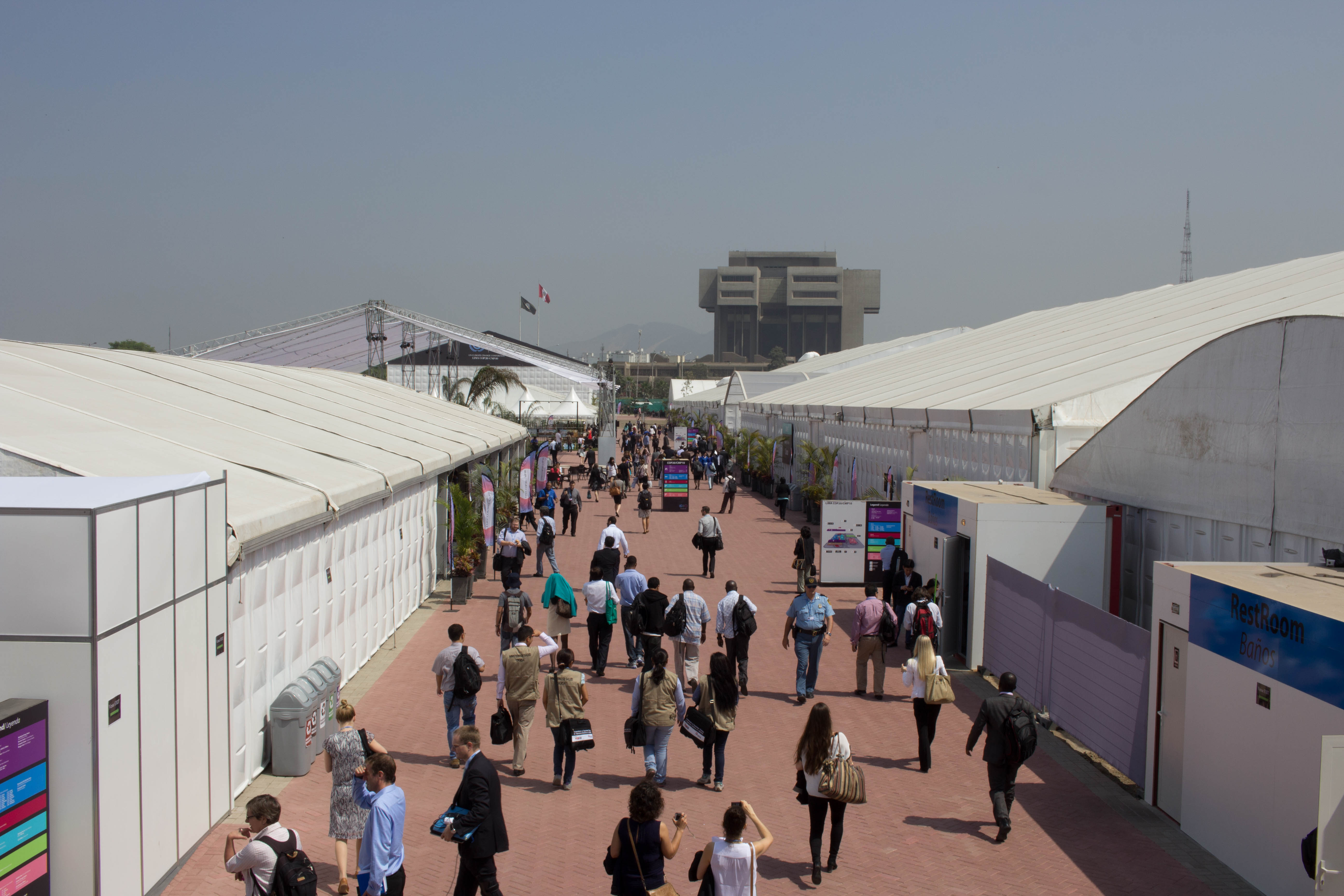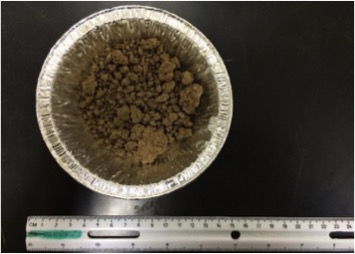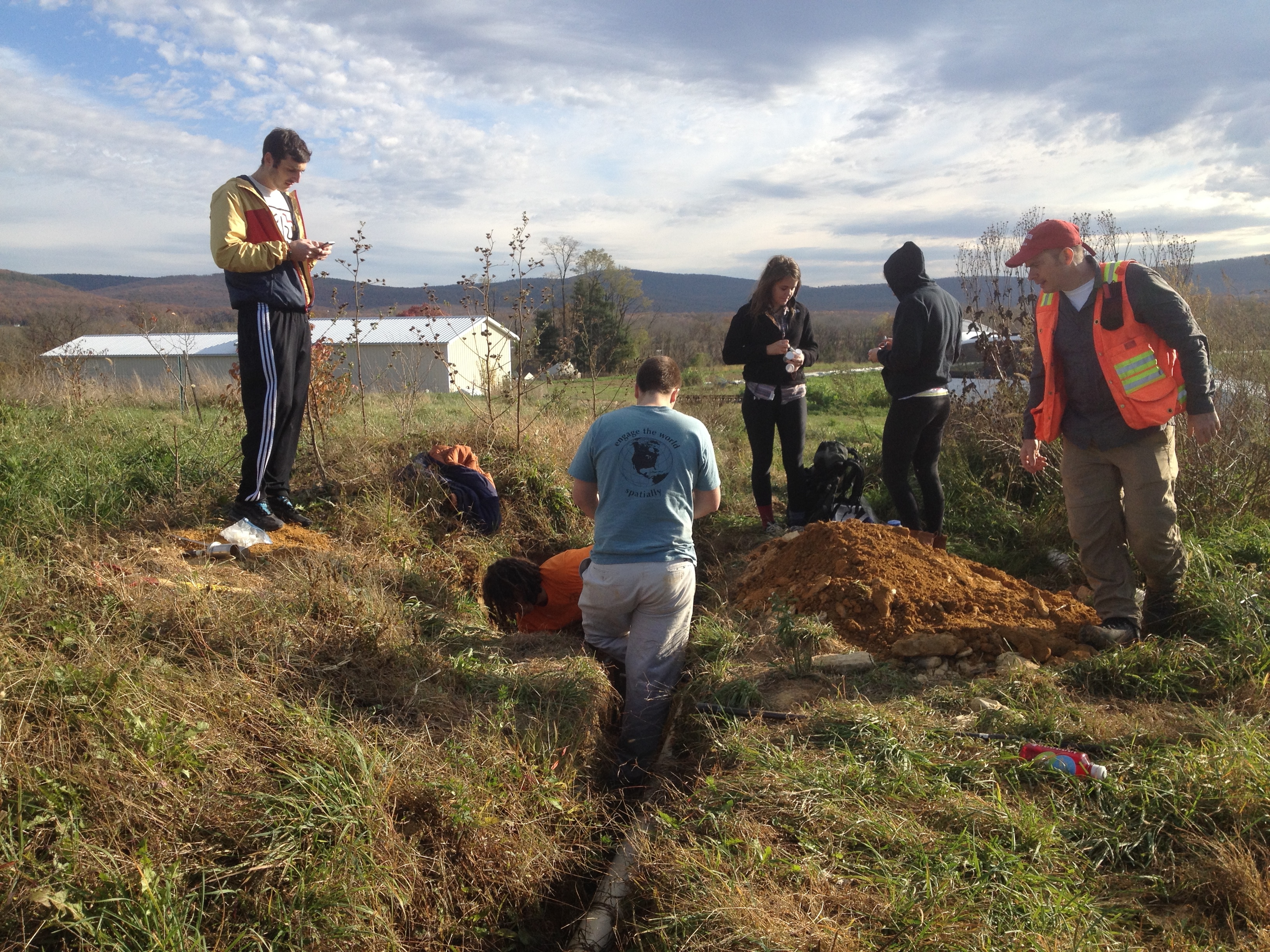Thus far our time in Lima has been spent sightseeing, for both people and places. We have been spending our days at Voces por el Clima interviewing delegates and representatives from various countries, Peru, Bolivia, Netherlands, and the Democratic Republic of Congo to name a few. While also exploring Lima outside of COP venues, we continue to run into party members and representatives. We were fortunate enough to have dinner with Gabriel Blanco a delegate from Argentina who has attended 9 previous COPs. Through a more relaxed interview involving cebiche and cerveza, Señor Blanco held nothing back about Argentina’s insufficient climate action. While it was surprising to hear about Argentina’s climate denial, it was even more surprising to me that Argentinas government continued to send delegates to a convention in which the argentine people had very little commitment towards. Leaving that dinner was a bit frustrating to hear that despite this being the twentieth conference of the parties, some governments are still in disagreement about the changing climate which is greatly impacting the lack of education for its citizens. Therefore a cycle of negligence occurs. However, Gabriel Blanco seemed somewhat optimistic for the outcomes in Lima, and we told him we will come to Argentina to help change the minds of the many Argentines who remain apathetic towards climate change.
Life Outside the COP: Voces Por el Clima
Just down the road from the COP 20 venue is the Jockey Club del Peru, the home of Voces por el Clima. Voces is an exhibition that showcases the different aspects of climate change, especially in Peru. The venue includes booths from a wide variety of organizations, as well as side events on topics from sustainable cities to indigenous peoples.
We usually arrive at Voces shortly after it opens at 10 am. We start our day in the food court, sending emails to contacts, planning out of day, and watching the COP which is being broadcasted live on the big screen. Around lunch time, the exhibitions begin to get more crowded, with lots of delegates coming over from the COP to enjoy the exhibitions. We have had great success conducting interviews both with delegates, and with representatives at the booths. Most people here are happy and excited to talk with us, whether it be in English or in Spanish. We have even had the opportunity to have dinner with Gabriel Blanco, delegate of Argentina, to talk about the COP and our research.


When not conducting interviews and exploring the many facets of Voces por el Clima, we had been soaking in the culture, food and sites of Lima. We are staying in a part of Lima called Miraflores, which is a more modern section of the city. However, we had the opportunity to explore the historic section of the city, even watching the changing of the guards at the Presidential Palace. We’ve eaten ceviche, sipped on chicha morado, and enjoyed the many free pisco sours. We are excited to get inside the COP next week, and to continue take in everything Peru has to offer.


The COP20Lima Tote Bag
 The Conference of the Parties is a very serious ordeal. Anyone who has been in the plenary rooms for the negotiations will tell you that the tension can be cut with plastic butter knife and that every minute counts. This conference is one where one of the greatest issues, if not the greatest issue, of this century is being discussed and potentially solved. This does not mean that the 5,000 attendees are constantly stressed, over-worked, and fearful for what future warming may hold. Fun can still be had, smiles and laughs are still present, and most of the people here are apparent of one thing other than climate change- the COP20 tote bag is the souvenir to get from the Peruvian Information booth.
The Conference of the Parties is a very serious ordeal. Anyone who has been in the plenary rooms for the negotiations will tell you that the tension can be cut with plastic butter knife and that every minute counts. This conference is one where one of the greatest issues, if not the greatest issue, of this century is being discussed and potentially solved. This does not mean that the 5,000 attendees are constantly stressed, over-worked, and fearful for what future warming may hold. Fun can still be had, smiles and laughs are still present, and most of the people here are apparent of one thing other than climate change- the COP20 tote bag is the souvenir to get from the Peruvian Information booth.

The bag is made out of recycled PET water bottles and features the COP20 logo. It is a hand tote that fits a 13” laptop perfectly and comes with several notebooks and a guide to some events happening throughout Lima over the span of COP. The bags are in high demand and in low supply, though. Only a few members of the Dickinson team were able to get them. This has led to lines, and frustration by hopeful toters when the information desk announces they have run out of the daily allotment. Other bags are given out, including one featuring a mountain scape of Peru and another slick gray bag with the Peruvian Ministry of the Environment’s crest subtly resting in the lower left corner.
The bag’s owners span the diverse gathering of COP attendees. From research students like myself, to members of NGOs and from activists to, negotiators and delegates this bags popularity has not been missed. So I thank the organizers of the COP for their introduction of this and many more elements that provide some fun to a place where critical conversations are had and pivotal decisions are made.
The Daily Schedule at COP20

Half of the Dickinson research team is into their fourth day at COP20 and we are starting to get into a bit of a groove, but in traditional COP fashion it is hectic and can shift without notice. It starts off for me with a 06:30 wake up time. I spend the next hour gathering my things, running across the street to the supermarket to grab my breakfast and lunch, and then walk to the shuttle bus to COP at 07:30. The bus rides are long, but provide a good place to meet Party delegates or other observers (that’s what we are). We also occasionally fall asleep on the busses, since they are so comfortable.

By 08:30 or 09:00 we arrive at the venue, after which we generally sit down for about an hour and talk about the coming day’s events or interviews. We then break off to either track down delegates to speak with, head to the exhibition hall to meet interesting people from all around the world, attend side-events, attend negotiation sessions, secretly slip into closed events until we are politely asked to leave, or conduct interviews. This morning I will be attending a side negotiation and text editing session on Climate Financing Mechanisms. This type of event is one where negotiators from the Parties attend and offer edits to text in the draft agreement or discuss the negotiations.
At 11:30 everyday most of the group attends the Climate Action Network (CAN) press conference in Press Room 2. This is a great 30 minute press briefing hosted by CAN, a global network of civil organizations. Three new panelists speak everyday, one is usually form Greenpeace and the other two are generally wild card NGOs. They touch on everything from negotiations around forestry to the discussions around what the “safe” warming limit is. Afterwards we grab the business cards of the three panelists, in hopes of interviewing them later.
The mornings go fast and by 12:00 we are all sweaty and exhausted, so at 12:30 we have the team meeting, eat some lunch, drink water, and rest our aching feet. Soon after we are back on the hunt for delegates or doing scheduled interviews. For instance my afternoon today involves and interview with a Professor from PSU, an NGO observer who we spoke with after a press conference, and an observer from a second NGO (CDKN) that works on knowledge brokering (post on this forthcoming).
The afternoon are also when most of the side-events occur. This afternoon I will be sitting in on one that is about promoting climate technologies. This events provide good information for our research paper, introduce new research, and are a great spot to find delegates or experts to interview about research topics. We also tend some time running around the exhibition hall doing quick interviews with those representing groups that pertain to our research.

Around 18:15 I generally head to the exit with a few others, but some of the group stays until 20:00. Once we are back in the city, we find a good dinner spot. Last night we had some Middle Eastern food, and the two nights before we enjoyed great local food at a restaurant called Mezze. After dinner, we all converge at Butler University’s abroad center. They have kindly offered it to us in the evenings as a meeting spot. Here we download the footage we shot throughout the day and discuss how the day went. Generally we are out of there by 22:30 and head back to the Flying Dog (our hostel).
For the next couple of hours I usually organize my things for the next day, take a shower, grab a bite to eat, download any more footage that wasn’t downloaded at Butler, and relax for a bit, always making it to bed by 01:00.
The Chemistry of Earth Systems
By Elizabeth Plascencia

As an Earth Sciences major in the 2014 Global Climate Change Mosaic, the elective course that I choose to enroll in was ERSC 331: The Chemistry of Earth Systems. This course is a major requirement and I also thought that it would be useful in addition to the ERSC 204: Global Climate Change mosaic course. Fundamentally this course has expanded my understanding of chemical principles and mechanisms behind major earth systems. The marriage between ERSC 204 and ERSC 331 further enabled me to comprehend the earth systems as a whole in understanding ocean acidification, thermal expansion, extreme weather-related events, anthropogenic environmental effects, natural hazards, etc.
Our final research project for this course revolved around the central theme of trace elements (particularly metals) in the environment as pollutants. Within our lecture course we were taught the differences between anthropogenic and geogenic sources of elements, so that once we began our field work in the Carlisle area we were able to make educated guesses on where to collect our soil samples. Scientific studies suggest that certain trace elements are more likely to be derived from anthropogenic sources while others are more likely to be geogenic, related to and sourced from the bedrock.
Our class was split into five research groups in order to help determine the sources and effects of pollutant trace elements since Carlisle has a large diversity of land-use. Once the research groups collected, analyzed, and presented their results, as a class, we attempted to infer the potential toxicity to the Carlisle population and environment.

The objective of my group research project was to discern the effect of transportation on soil chemistry, if any. Carlisle is a historical hotspot for truck traffic since its geographic location can reach over 100 million people within a 10-hour driving radius. Therefore, I-81 and the PA Turnpike are major areas for noxious emissions from the burning of oil and gas. Our sample technique consisted of collecting 10 soil samples on a vertical transect from I-81. We collected a sample every 10 meters from the road and proceeded to collect a top soil and deep soil sample in order to test for possible trace element accumulation overtime.

Our hypothesis is as follows: If truck traffic affects soil quality, then we should find high concentrations of trace elements closer to the highway near the soil surface. Trace element concentrations should exponentially decrease as we move away from the road and with depth. After XRD, XRF, and Total Carbon (TOC) analytical tests on our soil samples we concluded that Co, Cu, Zn, and Pb exponentially decreased as we moved away from the road. Zn and Pb also revealed a trend of exponential decrease with depth as well. Oddly enough we found that Na was extremely high above our Hagerstown background soil sample that we used as a standard to test against our soil samples. We soon realized that road salt was another anthropogenic source for this element.
Overall I found this material extremely helpful as an elective course for the mosaic. Further developing my understanding of the geochemical and geophysical reactions that drive the earth systems has helped me immensely.
Paradigm Shift
In my Religion and Modern Culture class, we have talked about paradigm shifts this semester which is directly related to the climate change conversation. The movie, “An Inconvenient Truth” is a, excellent example of a paradigm shift emerging. The movie, and the work of Al Gore, is an attempt at shifting the worldview of the climate change problem. The movie acts to summarize a brief synopsis of the problem and it does so in a way that can be easily understood to the general public and is easily relatable. Towards the end of the movie, Gore brings up the topic of the Kyoto Protocol. The United States originally signed the Kyoto Protocol but never ratified it; this caused a huge global controversy that continued along with the US not ratifying the second commitment period to Kyoto. Where the visible shift can be seen is through initiatives in the United States being taken in California and the nine north eastern states banding together to take action. In Gore’s presentation, he shows a list of a multitude of major cities that are in support of the Kyoto. This is where the paradigm shift is starting to be seen, at the bottom-up level.
He also mentions, towards the end of the movie that he is doing his part by doing what he can. This entails giving presentations in major cities all around the world, addressing people at a more local level. His approach of conveying the message and the approach of the movie is extremely similar to that of James Balog and the film Chasing Ice. Sitting and chatting with Balog on a more personal basis and seeing his presentation while he visited Dickinson really put a lot of things into perspective. Balog, in the same way that Gore does, conveys his message in the best way he possibly can, through his photography. Both men express a sense of urgency and the need for further communication. Gore mentions that the issue of the ozone hole has been depleted; the climate change problem is not completely out of our grasp. What is needed, is a complete shift in cooperation globally, a paradigm shift. Not everyone is currently sitting at the table, but everyone is invited.
Eight years has passed since this movie came out and the shift is still continuing; there is power growing. I think the Peoples Climate March, the largest climate march in history, that took place recently is an extremely powerful example of the movement. Well over 400,000 people took the streets of Manhattan to express their voices and to take a stand. However, the shift needs to continue. Even here at Dickinson College, ranked in the nation among the most environmentally friendly schools, still needs change. There are people that don’t think anything of their actions throughout their day, perhaps they should. Everything we do in our everyday lives, literally everything, has an impact. The amount of times I hear students and friends say that their minute actions make no difference, that one or two things makes no difference, is literally sickening. The fact that people can leave their phone charger plugged into a wall while it is not in use and it is still emitting .5 pounds of carbon into the atmosphere per hour is again, a sickening thought. People NEED to be more conscious. The shift must continue.
The title of the movie is what it is; the issue of climate change that needs to be addressed is inconvenient in many ways. It has been ignored for so many for way too long because people would rather pretend the problem is not there than actually address it head on. The novel, Merchants of Doubt, by Naomi Oreskes is a perfect example of doubt being used in many controversies over time. It is inconvenient both in that we have to deal with it and it’s impacts on today’s world, with some nations being more vulnerable than others. The definition of sustainability, to uphold the needs of today’s people without compromising the needs of future generations, relates to this inconvenience in that the paradigm shift must occur in order to comply with the needs of future generations.
The Inequality of the Get Richer Quick Schemes of the 1%
 Taking Professor Barnum’s class American Inequalities while in the mosaic has enabled me to really trace the pattern of poverty in those affected most by policy backfires. The housing crisis of 2008 leading to the Great Recession hit those who lost their mortgages and went through foreclosures the most even though the housing bubble burst because of irresponsible lending by large banks. As Joseph Stiglitz, the economist who coined the term the “1% and 99%” writes “the irony is that in the crises that finance brings about, workers and small businesses bear the brunt of the costs” (Stiglitz 66). The 1% can play around with the system in order to eke out as much profit as possible despite the harm its actions might cause the rest of society. The sad part is, the trickle-down effect is bogus. Increased profits for the 1% does not fuel the overall American economy because the richer one is, the smaller portion of their income they actually spend. Thus, those most defenseless against economic hardships are the ones most vulnerable to exploitation by the 1%.
Taking Professor Barnum’s class American Inequalities while in the mosaic has enabled me to really trace the pattern of poverty in those affected most by policy backfires. The housing crisis of 2008 leading to the Great Recession hit those who lost their mortgages and went through foreclosures the most even though the housing bubble burst because of irresponsible lending by large banks. As Joseph Stiglitz, the economist who coined the term the “1% and 99%” writes “the irony is that in the crises that finance brings about, workers and small businesses bear the brunt of the costs” (Stiglitz 66). The 1% can play around with the system in order to eke out as much profit as possible despite the harm its actions might cause the rest of society. The sad part is, the trickle-down effect is bogus. Increased profits for the 1% does not fuel the overall American economy because the richer one is, the smaller portion of their income they actually spend. Thus, those most defenseless against economic hardships are the ones most vulnerable to exploitation by the 1%.
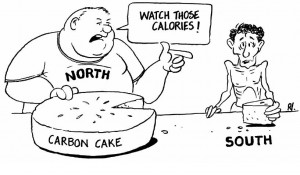
This reminds me of my research on LDCs and their vulnerability to climate change despite the fact that they did little to cause the problem. LDCs have contributed next to nothing in GHG emissions causing global climate change. Still, they will be the ones worst hit. Developed countries have been emitting GHGs for over a century, causing global climate change and as a result, have become rich and powerful in the global governance arena. Meanwhile, LDCs have stayed behind and will also be the first, and worst, hit by droughts, sea level rise, and temperature changes due to climate change. The fact that LDCs often still rely on subsistence agrarian societies- a sector way too reliant on climate considering the upcoming roller coaster. While developed countries have been able to develop away from agrarian societies and on the way caused climate change, LDCs have been left behind with agrarian societies put at great risks in the face of climate change.
LDCs, like the most impoverished in the US, are the ones hit hardest by the development schemes of the rich, yet they feel none of the benefits. This reflects a greater trend in all of society, where those who are poor are the most disadvantaged. There is no way for the poor to “pick themselves up by their bootstraps” while the rich are constantly tying them down through their own schemes of exploitation. Only when this trend is changed will policies have a possibility of creating more equal successes for all.
Klaus Keller at Dickinson
By Elizabeth Plascencia

This past Tuesday, November 11th, the ERSC Seminar Series welcomed a special guest from the Department of Geosciences at Penn State University, Klaus Keller. His lecture was called “Climate Risk Management in the Anthropocene: From Basic Science to Decision Making (and back)” and it directly related to our studies in both of the mosaic courses, ERSC 204: Global Climate Change and SUST 330: Global Environmental Challenges and Governance.
As Keller spoke about this whole notion of decision making under uncertainty, I could not help but directly relate it to the work under the UNFCCC (United Nations Conference on Climate Change). As December 1st approaches, our cohort has been wrapping up our relevant course materials as we prepare for our time at COP20. This lecture made it evident that uncertainties are truly still a roadblock in climate negotiations.
Keller’s perspective was extremely enlightening and I was eager to speak with him after his lecture. Fortunately, Will Kochtitzky ‘16 and I were able to chat with him after his talk and he gave us some great pointers about future work in climate change post-Dickinson.
Keller also spoke about the SCRiM (Sustainable Climate Risk Management) Scholars Program which particularly peaked my interests. It is essentially an interdisciplinary team of climate scientists, economists, philosophers, statisticians, engineers, and policy analysts from 19 universities and 5 research institutions across 6 nations. Together this team works to answer the looming question of: “What are sustainable, scientifically sound, technologically feasible, economically efficient, and ethically defensible climate risk management strategies?” My sense is that this program offers an incredible opportunity to anyone who is interested in pursuing work within climate change, sustainability, sustainable development, and/or sustainable risk management development. I personally am interested in possibly applying to the SCRiM Scholars Program.
Overall, I am very pleased to have had the opportunity to speak with Keller and I really can’t believe how close we are to attending COP20. Cheers.
For further reading, please feel free to check out this link
Climate Change is Simple
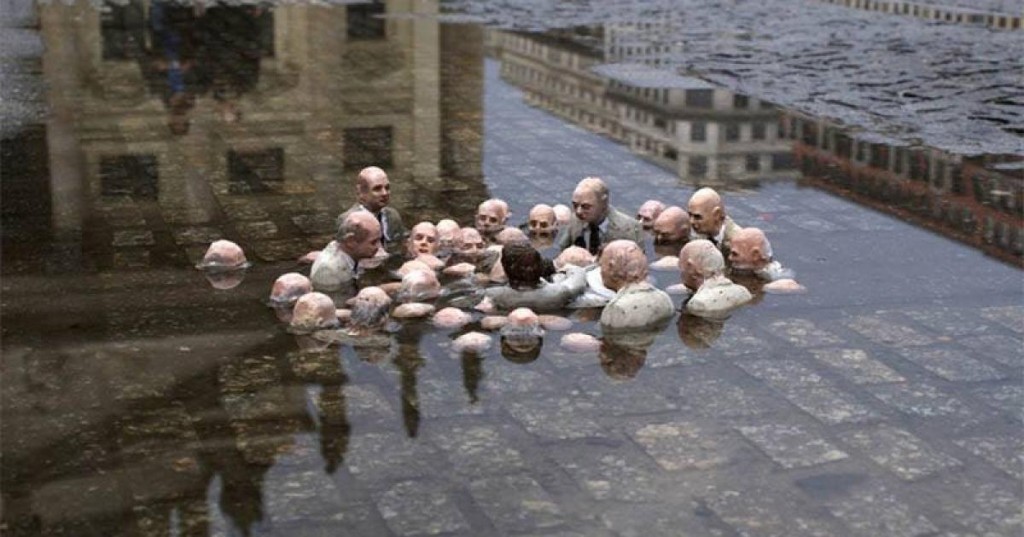
Why is no one talking about climate change?
A 2014 Gallop poll found that more than half (56 percent) of Americans are concerned a great deal or a fair amount about climate change. However, how often do you hear people bring up the subject of climate change in everyday conversation? It’s a downer, that’s true, but you think the impending doom of the climate as we know it would get more air time.
In a recent TED talk, David Roberts talks about why some people don’t like to talk about climate change- they think it’s too complicated.
Anytime you mention it, the hoards descend, bearing complicated stories about the medieval ice age or sun spots or water vapor… and you know there’s a lot of myths born by these climate skeptics but to debunk these myths you have to go online and research and read and be able to respond to them in detail and a lot of people just find that prospect dreary and so they don’t bother. -David Roberts
However, Roberts assures us that climate change is simple. You just need to know a few key facts.
1. Gases surround the Earth to warm it and keep it stable.
2. For the last 10,000 years the climate has been relatively stable (around +/- 1 degree C).
3. All advanced human civilization since the dawn of agriculture has taken place within this 10,000 year period of stability. In other words, our present society is built upon the Earth’s climate remaining the same.
4. However, humans are changing this past climate stability by burning fossil fuels and releasing carbon into the atmosphere. We’ve already raised the global average temperature 0.8 degrees C.
5. The data is very strong on the cause of climate change, but, in spite of this, we humans are not doing much to change our habits. Unfortunately, our present course leads to certain catastrophe.
The iconic “stay below 2 degrees C” is a goal almost certainly too high to be safe and too low to possible. At the rate we are going, global average temperatures could increase around 4 or 6 degrees C by the end of this century. This means a completely different Earth than the one we inhabit today. This means intense droughts, different coastlines, and vast amounts of uninhabitable land.
There are many complicated and fascinating discussions to be had about what to do about it or about what effect our actions might have on the climate and when or which policies are best based on cost benefit analysis. There’s complexity, plenty of complexity, for those who like complexity but we now know to a fair degree or certainty that if we keep doing what we are now doing, we will face unthinkable catastrophe.
That’s the bumper sticker, that’s the take home message.
And saying, ‘I don’t want to talk about that because I don’t know the ends and outs is like saying ‘I don’t want to raise alarms about Hitler’s army being 100 miles out because I don’t know the thread count of their uniforms or I don’t know the average calorie intake of a German solider. You don’t need to know those things to be scared that the army’s on the margin, to raise alarms about it.
-David Roberts
Now, it’s our job as citizens of the Earth to talk about what’s going to happen. We know potentially catastrophic change is coming. We know how to decrease the danger. Now we just have to take collective action as the human race.
[youtube_sc url=”http://www.youtube.com/watch?v=A7ktYbVwr90″ title=”Climate%20Change%20is%20Simple” border=”1″]
My Introduction to the Earth Sciences
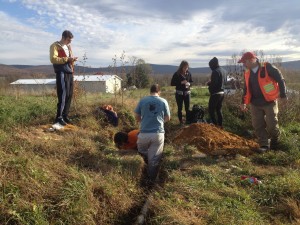
Having never taken a geology or earth science course before I thought it would be a good idea to use my elective space for Introduction to Soils. In general soil is not something I had ever thought a great deal about, except in relation to agriculture and runoff. So, getting to learn about the formation and evolution of soil types has been eye-opening to say the least. It is a complex field of study, with an incredible amount of variables. The class originally attracted me because of the implications soils have on construction and architecture. You can’t build a building and be certain it will last 50 years, without understanding what you are building on. Pertinent to this, I am conducting research on the strength of certain soil particle sizes in the hopes that I can understand what types of soils, generally, are good to build on. For instance, sand sized particles are obviously not going to be a strong surface to build on, but if mixed with a certain proportion of clay sized particles (compact and stick together well) could that sand become a strong building surface.
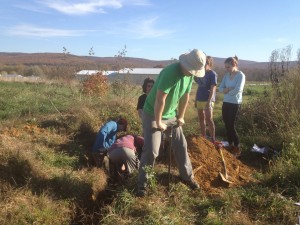
Beyond this research I have gained an appreciation for those who conduct soil surveys, because after reading through some of the literature and taxonomic guides I have found it is something that takes years of very specialized work to understand and be good at. These scientists also may have their work cut out for them as we being to see wetter soils and shifting landscapes due to flooding, fires, and inundation.




